|
Rispondi |
Messaggio 1 di 109 di questo argomento |
|
|
|
|
|
Rispondi |
Messaggio 65 di 109 di questo argomento |
|
|
|
|
Rispondi |
Messaggio 66 di 109 di questo argomento |
|
Terminator Code 311
Aldebaran highlighted by Venus' 'hyperdimensional turn' on July 4, also known as 'the Follower' or 'Torch-Bearer', is a 'red giant'. And it is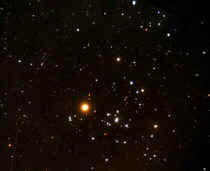 - a big reddish star, in the Hyades cluster representing the 'head' of the celestial bull Taurus. Aldebaran is usually seen as the right eye of the Bull, whereas the left eye is star '311' (Epsilon Taurus). Perhaps not widely used but the numeric '311' designation is repeatedly mentioned in The Orion Mystery by Robert Bauval: - a big reddish star, in the Hyades cluster representing the 'head' of the celestial bull Taurus. Aldebaran is usually seen as the right eye of the Bull, whereas the left eye is star '311' (Epsilon Taurus). Perhaps not widely used but the numeric '311' designation is repeatedly mentioned in The Orion Mystery by Robert Bauval:
It is... interesting to note that the 'eyes' of the bull were Aldebaran and star 311 (Epsilon Taurus), the latter being the 'left eye'. [p.158]
I found these 'eyes' to be a key to the 'riddle' of Terminator 3, released in mid-2003 right before the 'total recall' election won by Schwarzenegger, the occult 'Torch-Bearer' and a big Hollywood star...
Terminators are machines with artificial intelligence - A.I., which can be interpreted as 'eye' or 'a(n) eye'.  Terminators are also 'aliens' or 'foreigners' from the future making them comparable to Seth/Set the alien god. The Terminator's 'eye' would then be Set's eye, as are Aldebaran and star 311. (Remember, the Hyades represents Set so these stars are not only the Bull's eyes but also Set's eyes.) And 'Set eye' would be SETI - i.e. SET-I or SET-Eye... well, maybe. Terminators are also 'aliens' or 'foreigners' from the future making them comparable to Seth/Set the alien god. The Terminator's 'eye' would then be Set's eye, as are Aldebaran and star 311. (Remember, the Hyades represents Set so these stars are not only the Bull's eyes but also Set's eyes.) And 'Set eye' would be SETI - i.e. SET-I or SET-Eye... well, maybe.
The main ad graphic used for T3 encodes these associations. The Arnie-Terminator's face, taking up most of the space, emphasizes his red right eye as if to allude to Aldebaran, the red giant star representing the right eye of the Bull/Set. (It also evokes HAL the 'red eye' A.I. from 2001: A Space Odyssey.) And only one side of his face is illuminated... just like the Crabwood alien glyph, the Ultra-Tech picture, and Hoagland's 2003 Face picture! emphasizes his red right eye as if to allude to Aldebaran, the red giant star representing the right eye of the Bull/Set. (It also evokes HAL the 'red eye' A.I. from 2001: A Space Odyssey.) And only one side of his face is illuminated... just like the Crabwood alien glyph, the Ultra-Tech picture, and Hoagland's 2003 Face picture!
 At the Terminator's left-eye region is a reflected image of 'Terminator TX', the most advanced killing machine featured in the film. While capable of shape-shifting, TX appears mostly as a beautiful feline woman, seemingly alluding to the beastly feline/leonine left/east side of the Face on Mars... (And the lion is the most feared 'killing machine' on land.) At the Terminator's left-eye region is a reflected image of 'Terminator TX', the most advanced killing machine featured in the film. While capable of shape-shifting, TX appears mostly as a beautiful feline woman, seemingly alluding to the beastly feline/leonine left/east side of the Face on Mars... (And the lion is the most feared 'killing machine' on land.)
The 'TX' designation conjures up 'Texas', the official abbreviation of which is in fact 'TX'. Many scenes in the film are very Texas-like to underscore the connection.
It cannot be missed that Texas represents the political 'Ground Zero' in the post-9/11 period under the Bush presidency. Both Bush and Cheney are from Texas and have done shady dealings with corrupt Texas energy/oil corporations like Enron and Halliburton. Without Texas there probably would have been no Iraq invasion or even 9/11. Schwarzenegger has a shadowy Texas connection as well - a connection seemingly acknowledged in T3 as he utters 'TX corrupted me'...

The fact is, Arnie's rise in California politics has much to do with the state's disastrous energy situation (massive blackouts etc.) which in turn was driven by the corrupt practices of Texas energy companies, particularly Enron. It is known that Arnold met with Enron's CEO/Chairman Ken Lay in a private meeting convened in 2001 to discuss energy issues. As reported on August 14, '03 by IPA (confirmed by FTCR in Oct '03):
Consumer advocates with the Foundation for Taxpayer and Consumer Rights, Heller and Balber said today: "The California energy crisis was the culmination of a decade-long push to remove consumer protections and regulatory oversight of California's electric power system... Leading the charge was Ken Lay, the former CEO and Chairman of Enron, whose close ties with the Bush family were supplemented by campaign contributions both in Washington and across the country, notably including more than $100,000 to California Governor Gray Davis. It was, of course, no surprise that Governor Davis failed to meaningfully take on the power industry's manipulation of the California energy market during the crisis, opting instead to sign overpriced power contracts and force consumers and taxpayers to pay for the miserable failure of deregulation..."
"In order to counter the virtual public consensus that deregulation ought to be dumped, Ken Lay, during the spring of 2001, began a series of high-powered meetings to salvage the deteriorating argument for his energy scheme.... He met privately with Vice President Cheney in the days leading up to the administration's publication of what became an extremely Enron-friendly National Energy Plan. Successful on the national front as a result of his longstanding relationship with key Republicans, Lay hoped to regain his footing in California by forging ties with prominent Republicans in the state. In May of 2001, Lay convened a private meeting with junk bond king Michael Milken, Los Angeles' then-Mayor Richard Riordan and Arnold Schwarzenegger, at which Lay reportedly presented his vision of solving the state's energy deregulation crisis by, absurd as it sounds, expanding deregulation..."
Enron has since imploded of course, but Enron's backing of Schwarzenegger tells us a lot about his nature, or at least his assigned 'mission'... his destiny/fate. It is symbolically noteworthy that 'Enron' spelt backwards is 'Norne', the name of the 'three goddesses of fate' in Norse mythology.
 The idea of fate/destiny would then relate to such things as the 'Spear of Destiny', i.e. the holy lance of St. Longinus said to have pierced the side of Jesus. It's essentially an alter ego of the Holy Grail and said to have been possessed or sought by various messianic or antichristic leaders throughout history like Herod the Great, Constantine, Hitler, etc. The Spear represents the power that 'Antichrist' must possess in order to succeed in his endeavors. And this association suits Arnold's role well - the false Horus (i.e. Set) or the false 'messiah'... and/or indeed the 'Antichrist'/'Beast'. As I wrote on August 20, '03: The idea of fate/destiny would then relate to such things as the 'Spear of Destiny', i.e. the holy lance of St. Longinus said to have pierced the side of Jesus. It's essentially an alter ego of the Holy Grail and said to have been possessed or sought by various messianic or antichristic leaders throughout history like Herod the Great, Constantine, Hitler, etc. The Spear represents the power that 'Antichrist' must possess in order to succeed in his endeavors. And this association suits Arnold's role well - the false Horus (i.e. Set) or the false 'messiah'... and/or indeed the 'Antichrist'/'Beast'. As I wrote on August 20, '03:
...there is an allusion to the emergence of an antichrist in the Book of Revelation 9:11 (yes, 9-11):
And they had a king over them, which is the angel of the bottomless pit, whose name in the Hebrew tongue is Abaddon, but in the Greek tongue hath his name Apollyon.
...'Abaddon' and 'Apollyon', both mean the same thing - 'Destroyer'. [...] And of course... Schwarzenegger is none other than the 'Terminator'! [Arnie was also Conan the Destroyer (1984).]
The Terminator series is all about the end of the world or 'Judgment Day' (the title of the second installment), i.e. typical stuff from the Book of Revelation.
My interpretation has been that, like the Grail 'rose line', the Spear and its original possessor St. Longinus together allude to a longitudinal line (meridian), thus dovetailing with the foregoing Meridian theme. Even the name 'Terminator' is suggestive in that astronomically it refers to the line separating the illuminated and dark sides of a celestial body such as the Moon (and the line on the Moon tends to be longitudinal...)
The Spear of Destiny now resides in the Hapsburg Treasure House Museum in Vienna, Austria - the country where Schwarzenegger was born and raised.
So, we could say Schwarzenegger is a 'Trojan Horse' sent into the US government - ultimately the White House - to play the role of the Beast/Antichrist in the coming period of intense troubles... possibly World War 3 in which the United States would be the new Nazis, the 'Fourth Reich'. (Note: I'm not saying Arnie literally is the 'Antichrirst'/'Beast'.)
 This process was perhaps kick-started on 9/11, 2001 - exactly 225 years from the birth of the US (1776) and the year highlighted by 2001: A Space Odyssey, This process was perhaps kick-started on 9/11, 2001 - exactly 225 years from the birth of the US (1776) and the year highlighted by 2001: A Space Odyssey,  the ultimate red-eye A.I. ('HAL') movie. Closely related to this, it was the Odyssey probe that took the Face picture on Oct. 24, '02 showing its illuminated beast (eastern) half, discussed in Hoagland's paper published when Mars was making its close approach to Earth last year seemingly commemorating the 'rise of Schwarzenegger'. the ultimate red-eye A.I. ('HAL') movie. Closely related to this, it was the Odyssey probe that took the Face picture on Oct. 24, '02 showing its illuminated beast (eastern) half, discussed in Hoagland's paper published when Mars was making its close approach to Earth last year seemingly commemorating the 'rise of Schwarzenegger'.
I certainly find it fitting that it is in Homer's epic called The Odyssey ('the greatest tale of all time') that the story of the Trojan War is told, famous  for involving the Trojan Horse tactic masterminded by one 'Odysseus'. This shows that the ultimate 'false gift' (Trojan Horse), Odyssey, and '2001' are all closely intertwined. for involving the Trojan Horse tactic masterminded by one 'Odysseus'. This shows that the ultimate 'false gift' (Trojan Horse), Odyssey, and '2001' are all closely intertwined.
The Contact theme becomes more prominent in '2010: The Year We Make Contact', a sequel to '2001'. Its plot involves Jupiter transforming into a star which the original author Arthur C. Clarke (2010: Odyssey Two) calls 'Lucifer', i.e. Venus the 'light bearer'!
 Venus' July 4th 'hyperdimensional turning' at -19.5 deg. Galactic Meridian near the red-eye star Aldebaran carried all these associations. In a way the 'Super Torch Day' (7/4/04) was a 'Super Eye/A.I. Day'. Venus' July 4th 'hyperdimensional turning' at -19.5 deg. Galactic Meridian near the red-eye star Aldebaran carried all these associations. In a way the 'Super Torch Day' (7/4/04) was a 'Super Eye/A.I. Day'.
Now, while Aldebaran, the red/right eye, was clearly a key component of the encoded symbolism, we find more sinister and explosive implications attached to the left eye represented by star '311'.
First, in Terminator 3 are given specific time references to the beginning of 'Judgment Day', to be marked by world-wide nuclear detonations. There is one particular scene containing the following conversation between Arnold-Terminator and John Connor (future leader of mankind):

| Terminator: |
The first launch sequences will be initiated at 6:18 p.m. |
| John Connor: |
What, today? |
| Terminator: |
Affirmative. |
| Kate: |
John, what is he saying? |
| John: |
Judgment Day, the end of the world - it's today 3 hours from now. |
| Terminator: |
2 hours, 53 minutes. We must continue south into Mexico to escape the primary blast zones. |
The coding is quite simple: we can simply turn the numbers into days: i.e. '6:18' into 618 days and '2 hr 53 min' into 253 days. Based on the repeated references to 'today' or 'from now', we can count forward from July 2, 2003, i.e. Terminator 3's release date. This yields the following:
7/02/03 + 618 days = March 11, '05
7/02/03 + 253 days = March 11, '04
Both 'March 11', one year apart - leaving little doubt that the decoding is valid. And '3/11' is... yes, '311', as in the 'left eye' star 311!
http://www.goroadachi.com/etemenanki/sc2012-4.htm |
|
|
|
Rispondi |
Messaggio 67 di 109 di questo argomento |
|
Epsilon Tauri
From Wikipedia, the free encyclopedia
Epsilon Tauri
 The position of ε Tauri in the Taurus constellation. The position of ε Tauri in the Taurus constellation. |
Observation data
Epoch J2000 Equinox J2000 |
| Constellation |
Taurus |
| Right ascension |
04h 28m 37.00s [1] |
| Declination |
+19° 10′ 49.5″ [1] |
| Apparent magnitude (V) |
+3.53 |
| Characteristics |
| Spectral type |
K0III |
| B−V color index |
1.014 |
| Astrometry |
| |
| Proper motion (μ) |
RA: 106.19 ± 0.38 [1] mas/yr
Dec.: -37.84 ± 0.30 [1] mas/yr |
| Parallax (π) |
22.24 ± 0.25[1] mas |
| Distance |
147 ± 2 ly
(45.0 ± 0.5 pc) |
| |
| Details |
| |
| Mass |
2.7 ± 0.1 M☉ |
| Radius |
12.692 ± 0.545 [2] R☉ |
| Luminosity |
97 ± 8[3] L☉ |
| Temperature |
4901 ± 20 K |
| Metallicity |
+0.17 ± 0.04 |
| Age |
625 × 106 years |
| |
| Other designations |
74 Tauri, Ain, BD+18 640, CCDM 04286+1911, Coronis, FK5 164, GC 5430, HD 28305, HIP 20889, HR 1409, Oculus Borealis, SAO 93954
|
|
|
|
|
Rispondi |
Messaggio 68 di 109 di questo argomento |
|
ASENAT אָֽסְנַת
Asenat fue una mujer egipcia que vivió aproximadamente en el año 1715 a.d.M. Era una mujer perteneciente a la alta sociedad egipcia gracias a su padre Potifera, el cual, dice la Escritura, que era sacerdote de On. On era una ciudad en Egipto que significa “ciudad de la columna” ya que en ella abundaban los obeliscos, un símbolo pagano con mucha historia. Se ubicaba 17 km al norte de la ciudad moderna de El Cairo.
Gén 41:39 Y dijo Faraón a José: Pues que el Poderoso te ha hecho saber todo esto, no hay entendido ni sabio como tú. 40 Tú estarás sobre mi casa, y por tu palabra se gobernará todo mi pueblo; solamente en el trono seré yo mayor que tú. 41 Dijo además Faraón a José: He aquí yo te he puesto sobre toda la tierra de Egipto. 42 Entonces Faraón quitó su anillo de su mano, y lo puso en la mano de José, y lo hizo vestir de ropas de lino finísimo, y puso un collar de oro en su cuello; 43 y lo hizo subir en su segundo carro, y pregonaron delante de él: ¡Doblad la rodilla!; y lo puso sobre toda la tierra de Egipto. 44 Y dijo Faraón a José: Yo soy Faraón; y sin ti ninguno alzará su mano ni su pie en toda la tierra de Egipto. 45 Y llamó Faraón el nombre de José, Zafnat-panea; y le dio por mujer a Asenat, hija de Potifera sacerdote de On. Y salió José por toda la tierra de Egipto.
Yosef fue puesto en alto, para ese momento Yosef ya era oficialmente parte de la realeza egipcia, sin embargo es muy importante que él nunca se olvidara de su fe, esto fue lo que el Eterno vio en él y por eso siempre lo bendijo. Asenat, a pesar de ser completamente egipcia parece nunca haber sido un obstáculo para Yosef de manera que lo llevara a la idolatría. Recordemos que dentro de la historia de nuestro pueblo ha habido hombres (por ejemplo Salomón) que han sido desviados de su fe por causa de mujeres. Con Yosef no pasó esto, Asenat no lo desvió a él, más bien ella tuvo que haberse apegado a la fe de Yosef por el poderoso de Israel.
En la ciudad de On se adoraba al dios Ra, el dios sol, del cual era sacerdote Potifera padre de Asenat. El nombre de la ciudad de On fue cambiado posteriormente al de Heliópolis y se convirtió en una ciudad en la que también los griegos adoraron a sus deidades. Lamentablemente la adoración a esta deidad del sol contaminó al pueblo hebreo, lo podemos ver cuando el profeta Jeremías advierte a su pueblo que Nabucodonosor “va a quebrar las ciudades del Bet-Shemesh (casa del sol)” Jer. 43:13.Finalmente la adoración al sol es algo que se ha infiltrado en la iglesia cristiana-católica-romana, esto es para que nos demos cuenta de la fuerza que tenía esta deidad en sus seguidores y cómo ha repercutido hasta nuestros días, dicha deidad ha sido siempre lo opuesto al Poderoso de Israel. Todo esto es importante tomarlo en cuenta para entender el tipo de padre que fue Potifera para Asenat y cómo a pesar de haber sido instruida en ésta cultura la dejó y siguió a su esposo Yosef (José).
En esa época, un hombre que era sacerdote de Egipto era tenido en muy alta estima por su sabiduría y conocimiento. Sin duda Asenat era una mujer inteligente, instruida por su padre, pero la sabiduría que poseía era completamente la opuesta a la de Yosef (José). A pesar de esto veremos que en éste matrimonio conformado por un hebreo y una mujer extranjera al final logra prevalecer el temor de Yosef por el Elohim de Israel.
Es interesante el significado del nombre de Potifera, el cual significa "que pertenece a Ra" [dios del Sol] o "el que el [dios sol] Ra ha dado"
Por su parte, el nombre de Asenat significa adorador de Net" o el que pertenece a Neit" [una diosa]. REGALO DEL DIOS SOL
El nombre de Asenat escrito en hebreo es así: אָֽסְנַת y en hebreo el significado tiene que ver con: PELIGRO, INFORTUNIO.
El nombre Asenat aunque se escriba en hebreo es completamente egipcio en el que se declara que ella, Asenat pertenece a (la diosa) Neit, así como el nombre de su padre declara que él pertenece a Ra. Neit era la diosa madre de los dioses, por lo tanto madre de Ra. Era llamada «La Madre divina», «la dama de los cielos», «la dueña de los dioses». El cetro de su culto estaba en Sais, en el Delta. Los griegos la identificaron con Artemisa. Se pensaba que la diosa Neit se había creado a sí misma.
Como vemos, aunque Asenat venía de un contexto completamente pagano e idólatra y debido a eso su nombre era negativo, cuando es dada a Yosef por esposa es ella quien poco a poco con el paso del tiempo y el trato con Yosef a través de su testimonio se va dando cuenta de que la fe de Yosef en Un Solo Creador de todas las cosas es lo que verdaderamente el corazón del hombre anhela encontrar…
Gén 41:49 Recogió José trigo como arena del mar, mucho en extremo, hasta no poderse contar, porque no tenía número. 50 Y nacieron a José dos hijos antes que viniese el primer año del hambre, los cuales le dio a luz Asenat, hija de Potifera sacerdote de On. 51 Y llamó José el nombre del primogénito, Manasés; porque dijo: el Poderoso me hizo olvidar todo mi trabajo, y toda la casa de mi padre. 52 Y llamó el nombre del segundo, Efraín; porque dijo: el Poderoso me hizo fructificar en la tierra de mi aflicción.
El alma de Yosef se apegó a la de Asenat, ya hemos hablado de esto anteriormente y vimos que es un asunto muy delicado y especial cuando dos personas se unen físicamente, esto puede ser peligroso para un creyente que no esté bien cimentado en la fe si se una con una o un no creyente, podría ser el declive de su vida espiritual. En el caso de Yosef no fue así por causa de Asenat, primeramente porque el Eterno había permitido todo acontecimiento en su vida para llevarlo a cumplir un propósito específico y profético, y segundo porque Yosef sabía que él debía ser de testimonio para su esposa y no permitir que la cultura egipcia ganara terreno en la vida de su nueva familia, para esto fue necesario un corazón dispuesto de Asenat. En los nombres que Yosef pone a sus hijos podemos ver que el corazón de Yosef seguía confiando en el Eterno, los nombres Manasés y Efraím expresan la fidelidad del carácter de Yosef. Además vemos que Asenat no presentó alguna objeción en poner a sus hijos nombres hebreos, cuando ella al parecer venía de una familia en la que acostumbraban a poner a los hijos nombres en honor a los dioses.
Manasés hebreo Menashé מְנַשֶּׁה Podríamos decir que el Eterno recompensó a Yosef por todo lo que había pasado al darle a su primer hijo, y le consoló ayudando a olvidar el dolor que sentía al estar alejado de su familia pero por supuesto no podemos decir que ya no quería saber más de ellos y los olvidó.
Efraín hebreo Efrayim אֶפְרַיִם aquí vemos que Yosef entendió que el Eterno tenía un propósito al ponerle en Egipto y a pesar de la aflicción que sentía de estar ahí, alejado de los suyos en su hijo proyecta su confianza en el Creador quien le daba la bendición de hacer todo lo que hasta ese momento había logrado.
En todo ello estuvo Asenat, seguramente lo apoyó en todo momento, y es otro ejemplo de una mujer egipcia que se acerca al pueblo de Israel a través de un hombre hebreo. No sabemos lo que pasó con ella pero al ver en la vida de Yosef que todo se cumplió conforme a la voluntad del Eterno podemos decir que fue una mujer que dejó un ejemplo de sumisión a su marido para todas nosotras, sin embargo, puede ser importante que de las doce tribus Efraím hijo de Yosef y Asenat fue el que se alejó de la fe en pos de la idolatría de manera muy dolorosa para el Eterno, aún así Él no lo desechó y lo llamó “mi primogénito” “mi hijo”, precisamente para Efrayím fue enviado el mesías redentor como muestra del gran amor del Eterno por Su pueblo. Menashé también tuvo sus debilidades, eso podríamos atribuirlo a Asenat, madre de ambos, quien seguramente no cimentó la fe en sus hijos como lo hicieron otras mujeres extranjeras, por ejemplo como Rut. Aún así, vemos que de Asenat podemos rescatar una aceptación por la fe en el Eterno u no un obstáculo o rechazo, lo que posiblemente pudo darle entrada al pueblo de Israel si en verdad en algún momento de su vida lo deseó, después de todo es una mujer extranjera más que el Eterno usó para conformar las 12 tribus de Israel el pueblo elegido por el Creador para ser Suyo.
~El Lado Femenino De La Biblia~
www.elladofemeninodelabiblia.org http://www.elladofemeninodelabiblia.org/ladofemenino/html/Ejemplares/Asenat.htm |
|
|
|
Rispondi |
Messaggio 69 di 109 di questo argomento |
|
|
|
|
Rispondi |
Messaggio 70 di 109 di questo argomento |
|
Taurus (constellation)
From Wikipedia, the free encyclopedia
Taurus is one of the constellations of the zodiac, which means it is crossed by the plane of the ecliptic. Its name is a Latin word meaning "bull", and its astrological symbol is a stylized bull's head:  (Unicode ♉). Taurus is a large and prominent constellation in the northern hemisphere's winter sky. It is one of the oldest constellations, dating back to at least the Early Bronze Age when it marked the location of the Sun during the spring equinox. Taurus came to symbolize the bull in the mythologies of Ancient Babylon, Egypt and Greece. (Unicode ♉). Taurus is a large and prominent constellation in the northern hemisphere's winter sky. It is one of the oldest constellations, dating back to at least the Early Bronze Age when it marked the location of the Sun during the spring equinox. Taurus came to symbolize the bull in the mythologies of Ancient Babylon, Egypt and Greece.
There are a number of features of interest to astronomers. Taurus hosts two of the nearest open clusters to Earth, the Pleiades and the Hyades, both of which are visible to the naked eye. At first magnitude, the red giant Aldebaran is the brightest star in the constellation. In the northwest part of Taurus is the supernova remnant Messier 1, more commonly known as the Crab Nebula. One of the closest regions of active star location, the Taurus-Auriga complex, crosses into the northern part of the constellation. The variable star T Tauri is the prototype of a class of pre-main-sequence stars.
[edit] Characteristics
Taurus is a large and prominent constellation in the northern hemisphere's winter sky, between Aries to the west and Gemini to the east; to the north lie Perseus and Auriga, to the southeast Orion, to the south Eridanus, and to the southwest Cetus. In September and October, Taurus is visible in the evening along the eastern horizon. The most favorable time to observe Taurus in the night sky is during the months of December and January. By March and April, the constellation will appear to the west during the evening twilight.[5]
This constellation forms part of the zodiac, and hence is intersected by the ecliptic. This circle across the celestial sphere forms the apparent path of the Sun as the Earth completes its annual orbit. As the orbital plane of the Moon and the planets lie near the ecliptic, they can usually be found in the constellation Taurus during some part of each year.[5] The galactic plane of the Milky Way intersects the northeast corner of the constellation and the galactic anticenter is located near the border between Taurus and Auriga. Taurus is the only constellation crossed by all three of the galactic equator, celestial equator, and ecliptic. A ring-like galactic structure known as the Gould's Belt passes through the Taurus constellation.[6]
The recommended three-letter abbreviation for the constellation, as adopted by the International Astronomical Union in 1922, is "Tau".[2] The official constellation boundaries, as set by Eugène Delporte in 1930, are defined by a polygon of 26 segments. In the equatorial coordinate system, the right ascension coordinates of these borders lie between 03h 23.4m and 05h 53.3m, while the declination coordinates are between 31.10° and −1.35°.[7] Because a small part of the constellation lies to the south of the celestial equator, this can not be a completely circumpolar constellation at any latitude.[8]
[edit] Notable features
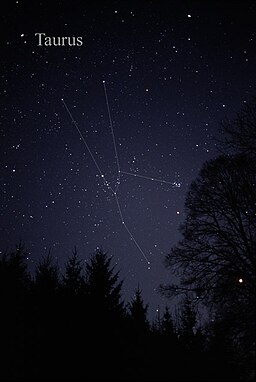
The constellation Taurus as it can be seen by the naked eye. [9] The constellation lines have been added for clarity.
During November, the Taurid meteor shower appears to radiate from the general direction of this constellation. The Beta Taurid meteor shower occurs during the months of June and July in the daytime, and is normally observed using radio techniques.[10] In October, between the 18th and the 29th, both the Northern Taurids and the Southern Taurids are active; though the latter stream is stronger.[11] However, between November 1 and 10, the two streams equalize.[12]
The brightest member of this constellation is Aldebaran, an orange-hued, spectral class K5 III giant star.[13] Its name is from الدبران al-dabarān, Arabic for "the follower" (of the Pleiades).[14] Forming the profile of a Bull's face is a V or A-shaped asterism of stars. This outline is created by prominent members of the Hyades,[16] the nearest distinct open star cluster after the Ursa Major Moving Group.[17] In this profile, Aldebaran forms the bull's bloodshot eye, which has been described as "glaring menacingly at the hunter Orion",[18] a constellation that lies just to the southwest. The Hyades span about 5° of the sky, so that they can only be viewed in their entirety with binoculars or the unaided eye. It includes a naked eye double star, Theta Tauri, with a separation of 5.6 arcminutes.[20]
In the northeastern quadrant of the Taurus constellation lie the Pleiades (M45), one of the best known open clusters, easily visible to the naked eye. The seven most prominent stars in this cluster are at least visual magnitude six, and so the cluster is also named the "Seven Sisters". However, many more stars are visible with even a modest telescope.[21] The name of the star Aldebaran most likely comes from the fact that it follows the Pleiades during the nightly motion of the celestial sphere across the sky.[14] Astronomers estimate that the cluster has approximately 500-1,000 stars, all of which are around 100 million years old. However, they vary considerably in type. The Pleiades themselves are represented by large, bright stars; there are also many small brown dwarfs and white dwarfs. The cluster is estimated to dissipate in another 250 million years.[22] The Pleiades cluster is classified as a Shapley class c and Trumpler class I 3 r n cluster, indicating that it is irregularly shaped and loose, though concentrated at its center and detached from the star field.
In the northern part of the constellation to the northwest of the Pleiades lies the Crystal Ball Nebula, known by its catalogue designation of NGC 1514. This planetary nebula is of historical interest following its discovery by German-born English astronomer William Herschel in 1790. Prior to that time, astronomers had assumed that nebulae were simply unresolved groups of stars. However, Herschel could clearly resolve a star at the center of the nebula that was surrounded by a nebulous cloud of some type. In 1864, English astronomer William Huggins used the spectrum of this nebula to deduce that the nebula is a luminous gas, rather than stars.
To the west, the two horns of the bull are formed by Beta (β) Tauri and Zeta (ζ) Tauri; two star systems that are separated by 8°. Beta is a white, spectral class B7 III giant star known as El Nath, which comes from the Arabic phrase "the butting", as in butting by the horns of the bull. It is the second brightest star in the constellation, and shares the border with the neighboring constellation of Auriga. As a result, it also bears the designation Gamma Aurigae. Zeta Tauri is an eclipsing binary star that completes an orbit every 133 days.[13]
A degree to the northwest of ζ Tauri is the Crab Nebula (M1), a supernova remnant. This expanding nebula was created by a Type II supernova explosion, which was seen from Earth on July 4, 1054. It was bright enough to be observed during the day, and is mentioned in Chinese historical texts. At its peak the supernova reached magnitude −4, but the nebula is currently magnitude 8.4 and requires a telescope to observe.[27][28] North American peoples also observed the supernova, as evidenced from a painting on a New Mexican canyon and various pieces of pottery that depict the event. However, the remnant itself was not discovered until 1731, when John Bevis found it.[22]
The star Lambda (λ) Tauri is an eclipsing binary star. This system consists of a spectral class B3 star being orbited by a less massive class A4 star. The plane of their orbit lies almost along the line of sight to the Earth. Every 3.953 days the system temporarily decreases in brightness by 1.1 magnitudes as the brighter star is partially eclipsed by the dimmer companion. The two stars are separated by only 0.1 astronomical units, so their shapes are modified by mutual tidal interaction. This results in a variation of their net magnitude throughout each orbit.[29]
[edit] History and mythology
Taurus as depicted in Urania's Mirror, a set of constellation cards published in London c.1825.
http://en.wikipedia.org/wiki/Taurus_(constellation)
|
|
|
|
Rispondi |
Messaggio 71 di 109 di questo argomento |
|
|
|
|
Rispondi |
Messaggio 72 di 109 di questo argomento |
|
Aldebarán de Tauro
De Wikipedia, la enciclopedia libre
| Aldebarán |
| アルデバラン (Arudebaran) |
| Sexo |
Masculino |
| Fecha de nacimiento |
8 de mayo |
| Edad |
20 |
| Tipo de sangre |
B |
| Origen en |
Manga |
| Altura |
2,10 m (6 pies 11 pulg) |
| Peso |
130 kg (286 lb) |
| Ocupación |
Santo de Atenea |
| Procedencia |
Brasil |
| Lugar de entrenamiento |
Brasil |
| Seiyū |
Tesshō Genda |
| Doblador(es) |
|
| Rango |
| Santo de oro |
| Constelación |
Tauro
|
| Técnicas |
- Great Horn
- Iron Arm (Episodio G)
|
Aldebarán (アルデバラン, Arudebaran?) es un personaje del manga y anime Saint Seiya conocido en español como Los Caballleros del Zodíaco. Fue el Santo de oro de Tauro hasta su muerte a manos de Niobe de Deep, después fue revivido por Atena, así que murió con los caballeros dorados en el Muro de los Lamentos
Su nombre está inspirado en la estrella Aldebarán, también conocida como α Tauri por ser la primera estrella de la constelación de Tauro. Según se explica en Lost Canvas, todo aquél que recibe la armadura de Tauro abandona su nombre original y pasa a ser llamado Aldebarán.
[editar] En el Episode G
Aldebarán aparece junto con otros Santos de Oro en la reunión dorada, más tarde es quien acompaña a Aioria y Líthos en su viaje hasta Jamir. Luego cuidaría a Mū después de que este tuviera su pelea con Jápeto de Dimensión. Es teletransportado a Grecia aun con las advertencias de Mū que no era del todo seguro hacer algo como eso. Y aparece para salvar a Shura y Aioria de las técnicas de Rea y Temis.[1] [2] [3]
[editar] En las 12 Casas
El Santo de Tauro pelea en contra de Seiya y en medio de la pelea lo reta a que le corte el cuerno de su casco, si logra hacerlo lo dejará pasar junto a sus amigos. Seiya despierta el Séptimo Sentido por un segundo y logra cortárselo, entonces el toro dorado muestra sabiduría y deja pasar a Seiya aconsejándole que de esta manera no pasaría a través de las doce casas y que tendría que desarrollar su séptimo sentido aún más para vencer o pelear al igual que los caballeros dorados.
Mientras que en el manga deja pasar a todos los santos de bronce, en el anime Shiryu, Hyoga y Shun pelearían ante Aldebarán ya que no los deja pasar a menos que le venzan. Así Shun lanza sus cadenas para rodear al toro dorado, pero éste se deshace de ellas fácilmente con solo abrir sus brazos, aunque esto era una distracción ya que Shiryu y Hyoga combinarían sus ataques del Dragón Naciente y el Polvo de Diamantes para atacar a Aldebarán, con lo que solo lograrían congelarle las manos. Aldebarán entonces se da cuenta de la valentía de los caballeros de bronce y que son confiables, así que los deja pasar, dándoles el mismo consejo que le dio a seiya.
Más tarde, Mu de Aries aparecería en el templo de Tauro a conversar con él y le dice que le podría reparar el cuerno perdido, pero Aldebarán se niega, ya que él prefería admitir la derrota, así se daría a conocer que Aldebarán podría haber tranquilamente matado a Seiya y los otros pero sintió el cosmos de Athena ayudándolos y decidió dejarlos pasar y derrotar al Patriarca. Tambien, en ese momento, sienten como la amenaza se acercaba a la deshabitada casa de Geminis.
[editar] En Asgard y Poseidón
Al principio de la saga de Asgard, Syd de Mizar va al Santuario y ataca por sorpresa a Aldebarán. Aunque el Santo bloquea sus golpes, no puede en contra de un segundo ataque hecho a sus espaldas por Bud de Alcor y es noqueado. Un cobarde ataque a traición, ya que ninguno de los dos luchó cara a cara contra Aldebarán. Cabe detallar que el ataque realizado por Bud de Alcor fue más bien para proteger a su hermano, y no por ser su "sombra". El dios guerrero estaba conciente que Aldebarán lo hubiera eliminado, ya que sus niveles eran diferentes. Ese ataque que realizo fue compulsivo, debido que en el fondo de su corazón, quería a su hermano.
En el manga, Aldebarán es el único Santo Dorado que le pone un alto a Sorrento de Sirena cuando este quiere atacar a los hospitalizados Santos de Bronce. Aunque tenía el poder y fuerza disminuido debido al hechizo de su flauta, se mostró resistente y combativo ante el General Marino, esta batalla es interrumpida por Athena.
La batalla contra Sorrento nunca fue concluida, aunque Tauro estaba en desventaja contra el general marino, mostró ser un caballero muy poderoso, utilizando desde ilusiones hasta usar su cosmoenergìa reducida para proteger a los santos de bronce de la melodía mortal de Sorrento. Se revela que tras la melodía mortal, Tauro queda desposeído de su armadura mientras Athena convence al general marino de llevarla ante Poseidón. Más tarde reaparece en el santuario junto con sus compañeros caballeros dorados preocupado por cómo se desarrollan las cosas en el Santuario Submarino y la imposibilidad de ayudar a los Santos de Bronce. Se presume que en el hospital, Aldebarán hubiera matado a Sorrento con un último ataque, costándole la vida, debido a que se despide del santo de Pegaso, encomendando a Atena a su cuidado. Esto indica que el santo de Tauro mataría al caballero de Poseidón, dado que si no fuera así, ignorando que Atena se disponía a detener la pelea, Sorrento hubiera matado a los santos de bronce sin problema alguno. Este pequeño detalle, que fue omitido en largas ocasiones, demuestra que el Santo de Tauro era capaz de eliminar a cualquier oponente que se le cruzara, aún si su poder fuera disminuido al uno por ciento.
En la saga de Hades mientras recordaba tranquilamente a una tierna niña que le dio una flor, esta flor se pudre y Tauro reconoce peligro cercano. El santo de oro no había percatado el cosmo del espectro, por lo que se cree que ellos tienen la especialización de ocultarlo y pasar desapercibidos. El mismo inconveniente sucedió con Mu de Aries, que estando en su templo, no se percató del grupo de espectros pasar a través de la casa. Aldebarán, en su último acto honorable mientras lanzaba una mirada de impotencia y tristeza por no poder mostrar sus poderes, usa un último Great Horn con gran poder, desintegrando tanto a Niobe como su armadura, demostrando que es uno de los que más fuerza física y cósmica tenia y quizás el que tenía el ataque más poderoso o destructivo de todos, ya que según el Manga, Aldebaran ha sido el único de Todos los Santos que ha desintegrado a un enemigo aun con armadura, de un solo golpe, pero debido a la necesidad del autor del manga en tener un Santo de Oro que mostrara el nivel de los otros guerreros, fue siempre usado como un saco de box o una vara de medición de poder. Luego, parte de su cosmos se mantiene en la casa de Tauro, advirtiendo a Mu de la presencia de espectros en el lugar y con esto le salva la vida a Mu, muriendo con dignidad.
Más tarde, revive en el infierno con el poder de Atenea y junto con sus 11 compañeros dio su vida para destruir el Muro de los Lamentos para dejar paso a los Santos de Bronce.
En el anime luego de su sacrificio le da un último mensaje a Seiya mientras su espíritu se desvanece en la Armadura de Tauro mostrándose alegre y orgulloso.
[editar] En las películas
Aldebarán tiene una mínima participación en la cuarta película, donde es asesinado fácilmente por los Seima Tenshi junto a los demás dorados que seguían vivos.
En la quinta película aparece en una pequeña escena juntó a sus compañeros caballeros dorados, el es petrificado junto a estos por rebelarse en contra de los dioses.
http://es.wikipedia.org/wiki/Aldebar%C3%A1n_de_Tauro
|
|
|
|
Rispondi |
Messaggio 73 di 109 di questo argomento |
|
|
|
|
|
www.youtube.com/watch?v=iS8Ej3e9bVI28 Mayo 2011 - 1 min. - Subido por aldebaran1765
Una pequeña demostración sobre la estrella Aldebarán. quien me inspiró ... el gigante rojo de la constelación de ...
|
www.taringa.net/posts/.../Aldebaran_-Constelacion-de-Tauro.htmlEn caché
Haz hecho público que te gusta. Deshacer
www.latinquasar.org/index.php?option=com_smf&Itemid...0En caché
Haz hecho público que te gusta. Deshacer
Haz hecho público que te gusta. Deshacer
es-la.facebook.com/public/Aldebaran-ConstelacionEn caché
Haz hecho público que te gusta. Deshacer
Haz hecho público que te gusta. Deshacer
Haz hecho público que te gusta. Deshacer
|
|
|
|
Rispondi |
Messaggio 74 di 109 di questo argomento |
|
| Aldebarán A/B |
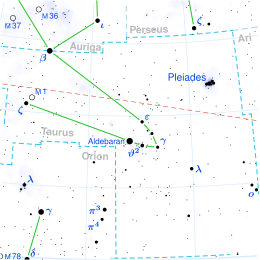
Ubicación de Aldelbarán en la constelación de Tauro. |
Datos de observación
(Época J2000) |
| Constelación |
Tauro |
| Ascensión recta (α) |
04h 35m 55,2s |
| Declinación (δ) |
+16° 30' 33,5 |
| Mag. aparente (V) |
+0,85 / +13,50 |
| Características físicas |
| Clasificación estelar |
Gigante naranja / Enana roja |
| Tipo |
K5III / M2V |
| Masa solar |
1,7 / 0,15 M☉ |
| Radio |
(44,2 / 0,36 R☉) |
| Índice de color |
1.90 (B-V)
1.54 (U-B) |
| Magnitud absoluta |
−0,63 / +11,98 |
| Luminosidad |
425 / 0,00014 L☉ |
| Temperatura superficial |
4010 / 3050 K |
| Metalicidad |
70% |
| Astrometría |
| Velocidad radial |
53,8 km/s |
| Distancia |
65,1 ± 1 años luz |
| Sistema |
| N.º de componentes |
Aldebarán A y B |
| Referencias |
| SIMBAD |
enlace |
| ARICNS |
enlace |
| Otras designaciones |
| 87 Tauri, Alpha Tauri, BD +16°629, Gl 171.1, GJ 9159, HD 29139, HIP 21421, HR 1457, SAO 94027 |
Aldebarán (Alfa Tauri / α Tau / 87 Tauri / HIP 21421)[1] es la estrella más brillante de la constelación de Tauro («El Toro») y la decimotercera más brillante del cielo nocturno. De magnitud aparente +0,85, es de color rojo anaranjado. Aunque visualmente parece ser el miembro más brillante del cúmulo abierto de la Híades, en realidad no forma parte del mismo y simplemente está en la misma línea de visión. Junto a Sirio (α Canis Majoris) y Arturo (α Bootis), permitió a Edmund Halley descubrir el movimiento propio de las estrellas mediante la comparación de sus posiciones de entonces con las que figuraban en los catálogos antiguos.
El nombre Aldebarán proviene del árabe الدبران, al-dabarān, cuyo significado es «la que sigue», en referencia a que esta estrella sigue al cúmulo de las Pléyades en su recorrido nocturno a través del cielo. En griego recibió el nombre de Omma Boos y en latín Oculus Tauri. En el siglo XVII, el astrónomo Giovanni Riccioli la denominó más específicamente Oculus Australis («ojo del sur»).[2]
En Persia la estrella era conocida como Satvis y Kugard. El astrónomo persa Al Biruni citaba Al Fanik («el camello semental»), Al Fatik («el camello gordo») y Al Muhdij («el camello hembra») como nombres indígenas árabes para esta estrella. En la antigua Roma recibía el nombre de Palilicium, término que proviene de Palilia o Parilia, la fiesta de Pales, divinidad pastoril de la mitología romana. El título de Hrusa designaba a esta estrella en la antigua Bohemia.[2]
En astronomía hindú se identifica con la nakshatra —mansión lunar— de Rohini, y es una de las veintisiete hijas de Daksha y la esposa del dios Chandra.[2]
[editar] Características físicas
|
|
|
|
Rispondi |
Messaggio 75 di 109 di questo argomento |
|
TERMINATOR 3 Y ALDEBARAN
OBSERVEN QUE ALLI AFIRMA QUE LA GUERRA/MARTE SE INICIA EL 2 DE JULIO (VERDADERA INDEPENDENCIA DE ESTADOS UNIDOS), QUE INSISTO LLEVADOS AL AÑO 30 DC, EN EL CONTEXTO A LA DIFERENCIA DE DOS DIAS DEBIDO A QUE EN LA REFORMA DEL CALENDARIO JULIANO-GREGORIANO SE HIZO DE 10 DIAS, EN LUGAR DE 12, EN EL CONTEXTO AL AÑO 30 DC, DICHO DIA VERDADERAMENTE FUE EN MARTES 4 DE JULIO DE 1776 EN LUNA LLENA. ¿PORQUE LA RELACION CON ALDEBARAN, EL OJO ISQUIERDO, DEL TORO? 2003 FUE EL AÑO 227 DESDE LA INDEPENDENCIA DE LOS ESTADOS UNIDOS. ESE AÑO FUE TAMBIEN INCLUSO EL ESTRENO DEL CODIGO DA VINCI.
NUMERO PHI Y PI

LA 
|
|
|
|
Rispondi |
Messaggio 76 di 109 di questo argomento |
|
AL PAN PAN Y AL VINO TORO
LA CONSTELACION DE LAS PLEYADES ESTA UBICADO EN TAURO/TORO
Has publicado que a ti también te gusta esto. Deshacer
Has publicado que a ti también te gusta esto. Deshacer
1 Corintios 1:19: Pues está escrito: Destruiré la sabiduría de los sabios, Y desecharé el entendimiento de los entendidos.
sabiduría/s-ophi-a/so-phi-a/sabado
Corintios/ORIN/ORION
INDEPENDENCIA DE ESTADOS UNIDOS, EN EL CONTEXTO AL 4 DE JULIO, A LA SALIDA DEL SOL
LA LLAVE(ORION) EN EL HORIZONTE/HORUS/SOL ROJO/MARTE EN EL CONTEXTO A LA SALIDA DEL SOL.
A 33 GRADOS ESTAN LAS PLEYADES.
THE BLAZING STAR IS ALDEBARAN
TERMINATOR 3 Y ALDEBARAN
OBSERVEN QUE ALLI AFIRMA QUE LA GUERRA/MARTE SE INICIA EL 2 DE JULIO (VERDADERA INDEPENDENCIA DE ESTADOS UNIDOS), QUE INSISTO LLEVADOS AL AÑO 30 DC, EN EL CONTEXTO A LA DIFERENCIA DE DOS DIAS DEBIDO A QUE EN LA REFORMA DEL CALENDARIO JULIANO-GREGORIANO SE HIZO DE 10 DIAS, EN LUGAR DE 12, EN EL CONTEXTO AL AÑO 30 DC, DICHO DIA VERDADERAMENTE FUE EN MARTES 4 DE JULIO DE 1776 EN LUNA LLENA. ¿PORQUE LA RELACION CON ALDEBARAN, EL OJO ISQUIERDO, DEL TORO? 2003 FUE EL AÑO 227 DESDE LA INDEPENDENCIA DE LOS ESTADOS UNIDOS. ESE AÑO FUE TAMBIEN INCLUSO EL ESTRENO DEL CODIGO DA VINCI.
NUMERO PHI Y PI

ENLACES
Everything is Connected and there are no
coincidences
|
|
|
|
Rispondi |
Messaggio 77 di 109 di questo argomento |
|
AL PAN PAN Y AL VINO TORO
LA CONSTELACION DE LAS PLEYADES ESTA UBICADO EN TAURO/TORO
1 Corintios 1:19: Pues está escrito: Destruiré la sabiduría de los sabios, Y desecharé el entendimiento de los entendidos.
sabiduría/s-ophi-a/so-phi-a/sabado
Corintios/ORIN/ORION
INDEPENDENCIA DE ESTADOS UNIDOS, EN EL CONTEXTO AL 4 DE JULIO, A LA SALIDA DEL SOL
LA LLAVE(ORION) EN EL HORIZONTE/HORUS/SOL ROJO/MARTE EN EL CONTEXTO A LA SALIDA DEL SOL.
A 33 GRADOS ESTAN LAS PLEYADES.
THE BLAZING STAR IS ALDEBARAN
TERMINATOR 3 Y ALDEBARAN
OBSERVEN QUE ALLI AFIRMA QUE LA GUERRA/MARTE SE INICIA EL 2 DE JULIO (VERDADERA INDEPENDENCIA DE ESTADOS UNIDOS), QUE INSISTO LLEVADOS AL AÑO 30 DC, EN EL CONTEXTO A LA DIFERENCIA DE DOS DIAS DEBIDO A QUE EN LA REFORMA DEL CALENDARIO JULIANO-GREGORIANO SE HIZO DE 10 DIAS, EN LUGAR DE 12, EN EL CONTEXTO AL AÑO 30 DC, DICHO DIA VERDADERAMENTE FUE EN MARTES 4 DE JULIO DE 1776 EN LUNA LLENA. ¿PORQUE LA RELACION CON ALDEBARAN, EL OJO ISQUIERDO, DEL TORO? 2003 FUE EL AÑO 227 DESDE LA INDEPENDENCIA DE LOS ESTADOS UNIDOS. ESE AÑO FUE TAMBIEN INCLUSO EL ESTRENO DEL CODIGO DA VINCI.
NUMERO PHI Y PI

ENLACES
Everything is Connected and there are no
coincidences
|
|
|
|
Rispondi |
Messaggio 78 di 109 di questo argomento |
|

Nineteen squared equals 361,
one degree more than a full circle.
Teotihuacan
North-south axis of whole site of Teotihuacan divided by distance between the centers of the Sun and Moon pyramids (2,400 meters / 800 meters) = 3.
The spacing of the city's streets, fifty-seven (57) meters divided by 3 = 19.
19 = 3 x 3 x 1.059 (the twelfth root of 2).
1.059 x 60 x 100,000 = 6,354,000. (Very near the span of the polar radius of the planet in meters.)
Harleston... believed that... he had also located Pythagorean triangles in the layout of the "Citadel" surrounding the temple of Quetzalcoatl, (and) proportions equal to pi, phi, and even the speed of light.
Mysteries of the Mexican Pyramids,
by Tompkins,
referenced in Ancient Stones Speak, Zink page 96
Cube to sphere ratio
When sphere = 10 then cube = 19.0983
When cube = 1, then sphere = 0.5236
Lindisfarne #10,
Cosmic Numbers and Temple Architecture: the Number Nineteen,
by Robert Lawlor,
pages 66- 99.
19 and the pentagon
The number nineteen also plays a unique role in the measure of the pentagon... the diagonal of the pentagon has the remarkable property of being the geometric mean between the diameters of the circumscribing circle and the height of the pentagon.
These numerical relationships which approach those of the Pharaonic canon of 18 and 19, are as follows:
-
diameter/diagonal=20/19.021=diagonal/height=19.021/18.092=1.051
page 11, Homage to Pythagoras: Rediscovering Sacred Science,
Christopher Bamford,
ed., Lindisfarne Press, 1994.
The number 19 is significant to the Baha'i, whose calendar is 19 months of 19 days each.
The Bahai also attribute significance to the number 95, which is 19 x 5. Coincidentally, the EarthStar western North America map actually has 95 points; the 19 'main' points, the points of the 19 triangles, the 19 'half-way' points on the inner ring, and the 38 points on the middle ring.
Return


Based on Richard Dannelley's book,
Sedona: Beyond the Vortexand Bruce Rawles
|
9.5 degrees north and south are the latitudes
where the apex points of a star tetrahedra within a sphere
will contact that sphere's surface,
when one apex is positioned at the north or south pole.
|
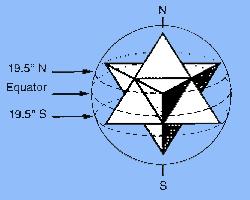
|
- On the Sun: sunspot activity and the region of peak temperatures is limited to 19.5 degrees north and south.
- On Venus: the presumably active major volcano complexes Alpha and Beta Regio are near 19.5 degrees.
- On Earth:
-
Mauna Loa, Hawaii (19 degrees 28 minutes N, 155 degrees 37 minutes W) The largest shield volcano is at 19.6 degrees north. This is Mauna-Kea volcano on the island of Hawaii.
-
Mexico City, Mexico (19 degrees 23 minutes N, 99 degrees 10 minutes W) The Pyramid of the Sun at Teotihuacan is at 19.6 degrees north.
-
Dzibalchen, (Yucatan), Mexico (19 degrees 28 minutes N, 89 degrees 46 minutes W)
-
Georgetown, Grand Cayman Island (19 degrees 18 minutes N, 81 degrees 26 minutes W)
-
Mount Emi Koussi, Chad, Africa (19 degrees 47 minutes N, 18 degrees 34 minutes E)
-
Mount Kalsubai, (near Bombay), India (19 degrees 33 minutes N, 73 degrees 43 minutes E)
-
Mountain near Xiangkhoang, Laos (19 degrees 17 minutes N, 103 degrees 17 minutes E)
-
Mountain near Potosi, Bolivia (19 degrees 13 minutes S, 66 degrees 22 minutes W)
-
Yasur Volcano, Tanna Island, Vanuatu (South Pacific Ocean) (19 degrees 31 minutes S, 169 degrees 25 minutes E)
-
Mount Samuel, Northwest Territory, Australia (19 degrees 13 minutes S, 134 degrees 8 minutes E)
-
Gweru, Zimbabwe, Africa (19 degrees 31 minutes S, 29 degrees 49 minutes E)
- On Mars: the "vast" Olympus Mons shield cone volcano is at 19.5 degrees. (see Mars)
- On Jupiter: the "red spot" which is an obvious vortex is at 19.5 degrees.
- On Neptune: in 1986 Voyager II discovered a similar spot at 19.5 degrees north.
Why '19.5 degrees' is Significant
19.5 degrees is the angle that's been found by researchers (Richard C. Hoagland, Stanley McDaniel, Erol Torun, Horace W. Crater, etc.) to be repeatedly encoded in the structures of Cydonia (see Mars).
It is viewed as a definite 'signal in the noise' - some kind of a 'message' left there by some intelligence. 19.5 is called t, the 'tetrahedral constant', because of its significance in tetrahedral geometry (a tetrahedron is a pyramid shape composed of four equilateral triangular sides): the apexes of a tetrahedron when placed within a circumscribing sphere, one of the tetrahedron's apexes touching the north pole, the other three apexes touch the surface of the sphere at 19.5 degrees south latitude.
Why this number would be important to the builders of the Martian structures is not clear (though Hoagland is theorizing that it has to do with what he calls "hyperdimensional physics").
Nile Time-Map & tetrahedral geometry - 19.5 degrees
The emphasis on 19.5 degrees is not confined to the Martian structures.
It has been found to be associated with various ancient structures here on earth, like Giza pyramids, Avebury (the largest stone circle in the world, near Stonehenge), Pyramids of the Sun and Moon at Teotihuacan, etc. It is also worth noting that the Egyptian hieroglyph for Sirius, the brightest star in the sky which was extremely important to ancient Egyptians, is an equilateral triangle which can be viewed as a 2-dimensional representation of a tetrahedron; and in the Egyptian translation, it means a doorway... a sort of 'stargate'.
Curiously, it has also been observed that 19.5 degrees is closely linked, for some reason, with the NASA space missions (for example, Mars Pathfinder landed at 19.5 degrees lat. of Mars on July 4, '97). In fact, not only did Pathfinder landed at 19.5 N, the longitude of the landing site was approximately 33 W - which is the very number of the longitude of the apex of the Great Bend of the Nile (33 E)!.
Now, this strongly insists on the relevance of the Nile numbers, and someone behind the scenes is well aware of it. As we move on, the number, 19.5, will also be very important in my Nile Time-map theory. Perhaps, as the Nile-Mars connection bridged by '19.5' appears to suggest, Mars was somehow involved during the 'Prometheus / Pandora period'.
|
|
|
|
Rispondi |
Messaggio 79 di 109 di questo argomento |
|
17 - Vesica piscis summation = 153 vesica psicis Arch-i-medes key - fish sacrifice September = i= 9 = Galactic center clockwise spiral 9-11 Jacob's ladder key - El-even key In ancient Roman religion and myth, Vulcan (Latin: Vulcanus) is the god of both beneficial and hindering fire,[1] including the fire of volcanoes. Vulcan is often depicted with a blacksmith's hammer.[2] The Volcanalia was the annual festival held August 23 in his honor. His Greek counterpart is Hephaestus, the god of fire and smithery. In Etruscan religion, he is identified with Sethlans. The festival of Vulcan, the Vulcanalia, was celebrated on August 23 each year, when the summer heat placed crops and granaries most at risk of burning.[1][15] During the festival bonfires were created in honour of the god, into which live fish or small animals were thrown as a sacrifice, to be consumed in the place of humans.[16] Tephaistos is the Greek word that defines the God whom the Romans gave the name of Vulcan. Hence Sanconiatho and curios similarity of names and occupations, tended to derive the name of Tubal Cain to Vulcan by means known to etymologists. omitting the initial T of Tubal Cain, which is the article in the Phoenician language, and no vowel, the word is formed by the nature Balcan Interchangeable B and V is easily transformed into Vulcan. Vulcan was a sun deity who was associated with fire, thunderbolts, and light. The festival in honour of him was called the Vulcania in which Human sacrifices were offered. "According to Diel, he bears a family relationship to the Christian devil.' It is fascinating to know that he married Venus, another name for Lucifer or the devil. What is even more interesting is that Vulcan is adored in Masonry under the name of Tubal Cain. In the Masonic Quiz Book the question is asked: "Who was Tubal Cain?" The answer is: "He is the Vulcan of the pagans.' In Masonry, Tubal Cain is the name of the password for the Master Mason (or third) degree. Listen to what occultist and Mason, Manly Palmer Hall, has to say: "When the Mason learns that the key to the warrior on the block is the proper application of the dynamo of living power, he has learned the mastery of his craft. The seething energies of Lucifer are in his hands and before he may step onward and upward, he must prove his ability to properly apply energy. He must follow in the footsteps of his forefather, Tubal-Cain, who with the mighty strength of the war god hammered his sword into a ploughshare.' There is also a sexual connotation associated with Vulcan and Tubal Cain. Former Mason, Bill Schnoebelen, explains: "For Masons who wish to conceal their membership from non-Masons, but still advertise it to their Lodge brothers, there is a special pin (or tie tack) they can wear. It looks like an upside down golf club with two balls near the top....Many people assume the person is a golfing enthusiast, but it is actually a visual Masonic pun. "This is called the 'Two Ball Cane,' and is a pun on the secret password of a Master Mason, 'Tubalcain (sic).'...It is also an all-too-obvious pun on the 'god' of Masonry, the male reproductive organ. In Dowland manuscript we reads as follows: "Before the flood there was a man called Lamech as is written in the Bible in the fourth chapter of Genesis, and this Lamech had two wives, one named Adah and the other Zillah; of Ada first wife had two children, one named Jubal Jubel and the other, and his second wife had a son and a daughter. These four sons founded the principle of all sciences in the world. the firstborn Jubel founded the science of geometry and was engaged in driving sheep to the field, and first built houses of wood and stone, as stated in the chapter above. and his brother Jubal founded the science of music and songs of the tongue, the harp and the organ. and the third brother, Tubal Cain, founded the guild of smiths who worked in gold, silver, copper, iron and steel, and his daughter founded the art of weaving. and these children knew well that God would punish the sins through fire or water, for which reason they wrote the sciences that had been founded on the pillars to be found after the flood. One pillar was marble and could not burn in the fire, the other was of copper and could sink into the water. " 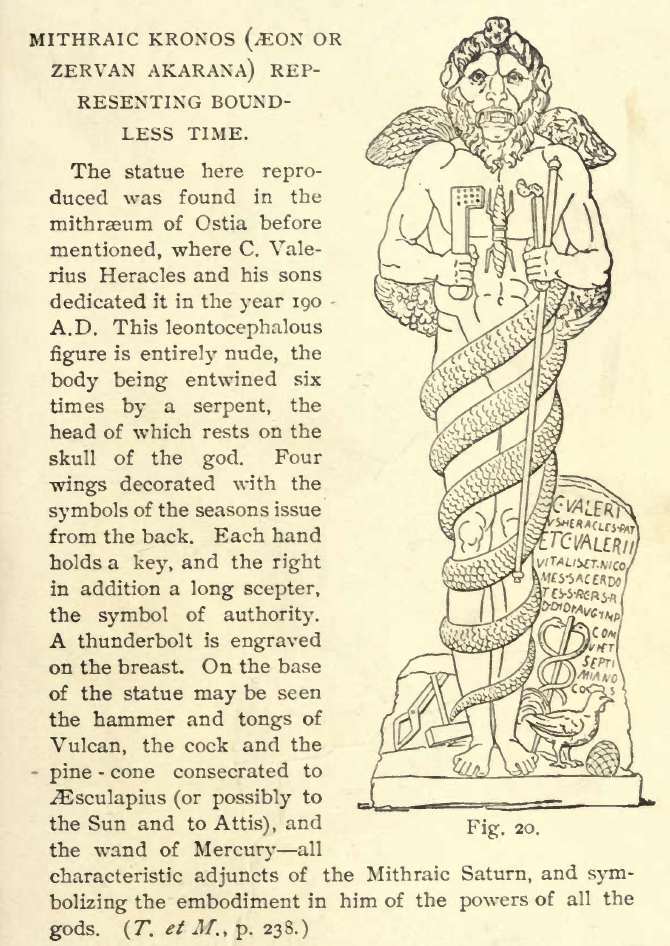 Connect dots
| Attachments: |

CAPRICORN MAX ERNST.JPG [ 166.76 KiB | Viewed 2064 times ]
|
_________________
E.T.A.E
Everything is Connected and there are no
coincidences
|
|
|
 Primo Primo
 Precedente
65 a 79 de 109
Successivo Precedente
65 a 79 de 109
Successivo Ultimo
Ultimo
|

